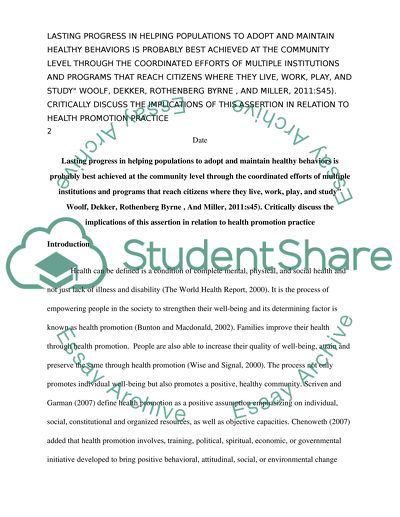Cite this document
(“Lasting progress in helping populations to adopt and maintain healthy Essay”, n.d.)
Lasting progress in helping populations to adopt and maintain healthy Essay. Retrieved from https://studentshare.org/psychology/1645508-lasting-progress-in-helping-populations-to-adopt-and-maintain-healthy-behaviors-is-probably-best-achieved-at-the-community-level-through-the-coordinated-efforts-of-multiple-institutions-and-programs-that-reach-citizens-where-they-live-work-play-and-s
Lasting progress in helping populations to adopt and maintain healthy Essay. Retrieved from https://studentshare.org/psychology/1645508-lasting-progress-in-helping-populations-to-adopt-and-maintain-healthy-behaviors-is-probably-best-achieved-at-the-community-level-through-the-coordinated-efforts-of-multiple-institutions-and-programs-that-reach-citizens-where-they-live-work-play-and-s
(Lasting Progress in Helping Populations to Adopt and Maintain Healthy Essay)
Lasting Progress in Helping Populations to Adopt and Maintain Healthy Essay. https://studentshare.org/psychology/1645508-lasting-progress-in-helping-populations-to-adopt-and-maintain-healthy-behaviors-is-probably-best-achieved-at-the-community-level-through-the-coordinated-efforts-of-multiple-institutions-and-programs-that-reach-citizens-where-they-live-work-play-and-s.
Lasting Progress in Helping Populations to Adopt and Maintain Healthy Essay. https://studentshare.org/psychology/1645508-lasting-progress-in-helping-populations-to-adopt-and-maintain-healthy-behaviors-is-probably-best-achieved-at-the-community-level-through-the-coordinated-efforts-of-multiple-institutions-and-programs-that-reach-citizens-where-they-live-work-play-and-s.
“Lasting Progress in Helping Populations to Adopt and Maintain Healthy Essay”, n.d. https://studentshare.org/psychology/1645508-lasting-progress-in-helping-populations-to-adopt-and-maintain-healthy-behaviors-is-probably-best-achieved-at-the-community-level-through-the-coordinated-efforts-of-multiple-institutions-and-programs-that-reach-citizens-where-they-live-work-play-and-s.


